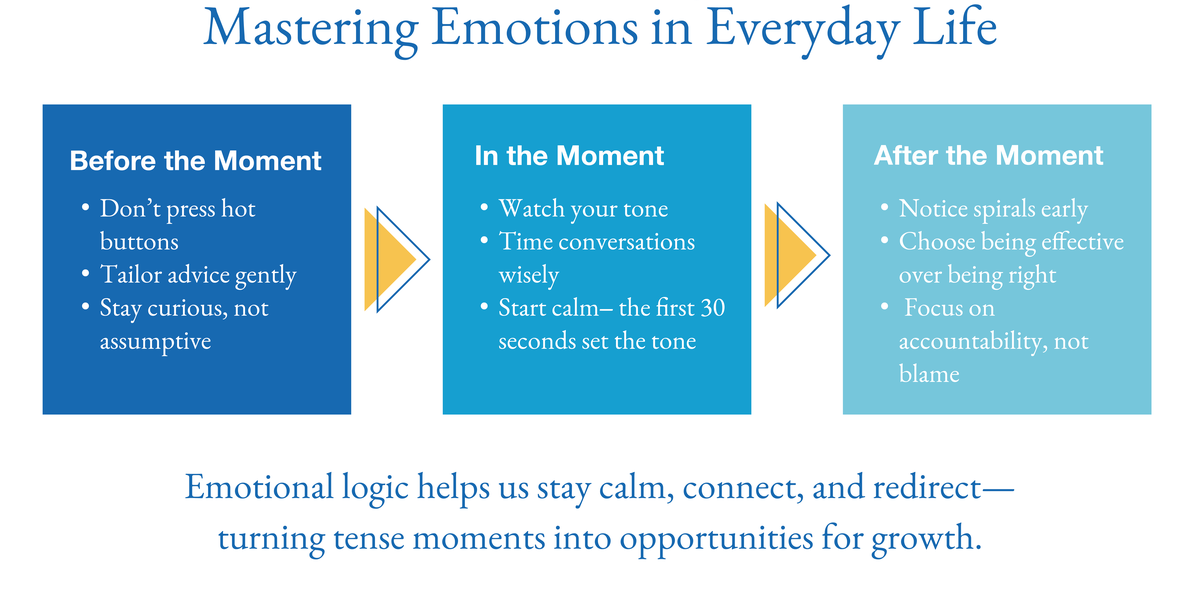Emotional Logic Can Help Strengthen Relationships and Ease Conflicts
When you’re choosing the fastest route to work or fixing a leaky pipe, analytical logic works beautifully. Step-by-step reasoning leads to predictable results. But when it comes to raising children, handling conflict, or building strong relationships, that kind of logic breaks down. Human moments aren’t mechanical—they’re emotional.
That’s where emotional logic comes in.
Emotional logic is your real-time operating system for high-stakes human interactions. It isn’t logic in the traditional sense—it doesn’t rely on hard facts or fixed equations. Instead, it’s the ability to read emotional cues, regulate your own responses, and make decisions that strengthen connection and defuse tension.
It’s a form of applied emotional intelligence: a flexible, moment-to-moment skillset that helps you stay calm, connected, and effective when emotions are high and outcomes matter.
The Morning Breakdown
Consider the following everyday moment between a parent and child:
It’s a hectic morning. Johnny’s mom is trying to get all the kids into the minivan for carpool. The kitchen is chaotic. She’s overwhelmed and short on time.
Mom (sharply): “Put on your shoes, Johnny. You’re late for school.”
(Johnny looks down at his feet but doesn’t move. He seems frozen.)
Mom (more frustrated): “And put your things away!”
(Johnny remains listless.)
Mom (now overwhelmed): She loses it and yells. Johnny cries and still doesn’t move.
From a rational standpoint, it seems simple: Johnny was given two instructions and didn’t act. But through the lens of emotional logic, something else is happening. He wasn’t being defiant—he was reacting to his mother’s tone. His nervous system entered a mild freeze response. His silence wasn’t rebellion, but distress.
His mother misread the moment, and the interaction spiraled.
This moment didn’t fall apart because of bad intentions. It fell apart because emotional logic wasn’t applied.
Three Everyday Applications of Emotional Logic
Emotional logic is most useful in emotionally charged moments—when stakes are high and reactions can quickly spiral.
Here are three common situations where emotional logic helps you stay effective and connected:
Before the Moment: Preparing Your Mindset
How you enter an interaction often shapes how it unfolds. A centered mindset can prevent unnecessary friction.
- Avoid emotional hot buttons. Know what tends to trigger others—and don’t start there.
- Know the listener’s filter. Treat advice as a gift; wrap it gently, especially for those prone to low self-worth or highly sensitive to criticism.
- Don’t assume others operate by your logic. We often think others see things the way we do. Stay curious: What might they be feeling? What are they focused on?
In the Moment: Navigating Emotional Interactions
During emotionally charged conversations, your tone, timing, and presence often matter more than your words.
- Watch your emotional tone. Emotions are contagious. Stay grounded, and others are more likely to follow.
- Time it well. Don’t raise hard topics when someone’s already stressed, tired, or upset.
- Try the 30-Second Rule. Begin every difficult conversation with calm presence before jumping into content.
After the Moment: Repairing and Reconnecting
Even with the best intentions, emotions can take over. When that happens, these simple shifts help you get back on track:
- Notice spirals early. If tension is rising, pause and reset. Don’t push forward just to prove a point.
- Choose to be effective over being right. Winning the argument might feel good—but it can damage the relationship. Prioritize understanding and resolution.
- Focus on accountability, not accusation. Blame triggers defense; accountability fosters repair.

Returning to Johnny and His Mom
It’s clear that both Johnny and his mom became emotionally charged during their exchange. Already tense, the mom began with a sharp tone—a harsh startup that set the emotional tone for what followed. From there, the two spiraled.
But what if she had paused and noticed his stillness? She might have softened her approach:
“Hey bud, I know I said that sharply. Are you okay?”
That single emotional shift—rooted in empathy and self-awareness—could have changed everything.
Moments like this don’t always come naturally. But once we train ourselves to recognize emotional dynamics in real time, we can all grow better at using emotional logic—choosing responses that calm, connect, and redirect rather than escalate.
Final Thoughts
Emotional logic is what helps us steer when the road gets bumpy. Brilliance in planning is the floor. Emotional logic is the ceiling. Without it, your effectiveness, relationships, and even your health plateau. It’s the skill that lets you keep growing.
Mastering emotional logic is like learning to play music. It’s built through consistent attention, reflection, and practice. The more you understand the emotional patterns of others—and yourself—the more gracefully you can improvise under pressure.
Emotional logic doesn’t make you perfect—it makes you present, steady, and skillful when it matters most.



